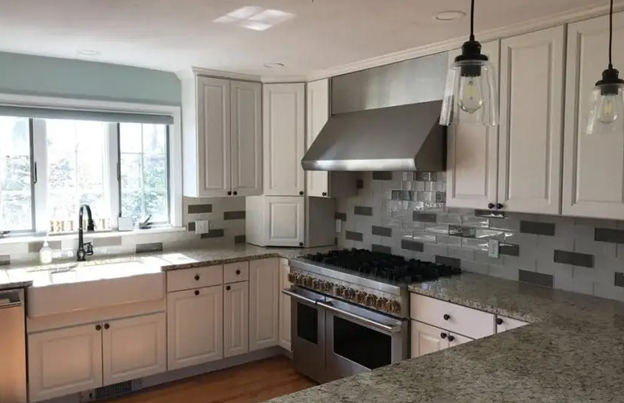When choosing a range hood for your kitchen, it’s important to consider several factors. Start by understanding your kitchen’s layout and ceiling height, and make sure there’s enough space for installation. Think about the cubic feet per minute (CFM) needed based on your cooktop size, how often you cook, and the type of stove you have. This helps ensure proper smoke extraction. Consider the size of the hood itself to effectively remove smoke. Think about noise levels, venting options, installation requirements, and how your budget aligns with the quality and type of hood you need. By considering these factors, you can find a range hood that fits well in your kitchen and meets your cooking needs.
1.Kitchen Configuration
Range Placement
Understanding the layout of your kitchen is paramount when selecting the right range hood. The placement of your range determines the type of hood that best suits your needs. For instance, a wall-mounted range hood is ideal if your range is against a wall. If the range is beneath cabinets, opt for an under-cabinet range hood. Kitchen islands call for island range hoods, while custom cabinetry or specialized hoods require range hood inserts. Additionally, outdoor kitchens demand durable, weather-resistant outdoor range hoods.
Ceiling Height
Considering the height of your kitchen ceiling is crucial for proper installation. If your ceiling is exceptionally tall, a chimney extension may be necessary to cover the ductwork effectively. Ensuring the right fit and coverage is essential for optimal functionality.
Mounting Space
Determining whether your range hood can be adequately mounted is another key consideration. The recommended distance between the hood and the cooktop varies for indoor and outdoor kitchens. Indoor hoods are typically mounted between 28 and 36 inches away, while outdoor hoods need to be positioned 36 to 42 inches from the surface of the cooktop. Ensuring you have the necessary space for installation is fundamental for efficient venting.
2. Range Hood CFM (Cubic Feet per Minute)
Cooktop Size
Matching the cubic feet per minute (CFM) of your range hood to the size and power of your cooktop is crucial for effective ventilation. Larger cooktops with higher BTUs (British Thermal Units) require a more powerful hood. Gas ranges, with their BTU measurement, may need a higher CFM compared to electric ranges, which are measured in watts. Calculating the minimum CFM based on your specific cooktop’s output ensures that your range hood can handle the generated heat and smoke effectively.
Cooking Habits
Considering your cooking habits is an often-overlooked aspect when choosing a range hood. If you are an avid cook, particularly if you enjoy preparing Asian dishes or frequently use methods that produce grease and smoke, opting for a higher CFM range hood is advisable. Tailoring the hood’s power to your cooking preferences enhances its efficiency and longevity.
3. Range Hood Size
Indoor Kitchens
Selecting the right size for your range hood is crucial for effective smoke and fume extraction. For indoor kitchens, a general guideline is to size the hood three inches larger than your range on each side. This additional coverage ensures that all the smoke and fumes produced during cooking are effectively captured and vented.
Outdoor Kitchens
Outdoor kitchens necessitate larger hoods to accommodate the size of the grill. Sizing your outdoor hood at least six inches larger than your grill on each side ensures efficient ventilation for the open-air cooking environment.
4. Noise Level
Considerations
The noise level of a range hood, measured in sones, is an important factor, and the balance between power and noise must be considered. While a quieter range hood is generally preferred, it’s crucial to note that a quality range hood, even with higher CFM, shouldn’t be excessively loud. Finding a balance between power, noise, and the efficiency of the motor is key. Customers often appreciate the option to run their range hoods on lower speeds to minimize noise levels.
5. Exhaust Type – Vented & Non-Vented
Vented Systems
Choosing between vented and non-vented systems is a critical decision in range hood selection. Vented systems use ducting to expel air outside, offering an effective way to eliminate cooking odors and fumes. These systems provide flexibility with venting options, allowing for horizontal or vertical ducting. On the other hand, non-vented or ductless systems recirculate air through charcoal filters, making them suitable for situations where installing ductwork is challenging. While not as effective as vented systems, they can be a practical choice for apartments or spaces where duct installation is not feasible.
6. Installation Time and Cost
DIY vs. Professional Installation
Understanding the installation process and associated costs is crucial for homeowners. Many range hoods can be installed as a do-it-yourself (DIY) project, with instructional videos available for guidance. However, it’s essential to assess whether professional installation might be necessary based on the complexity of the hood and your own comfort level with installation tasks. Factoring in installation time and potential costs ensures a smooth and successful installation process.
7. Budget
Factors Affecting Budget
Considering your budget is the final but no less important step in the range hood selection process. Several factors contribute to the overall cost, including the quality, material, size, power, and type of hood. Higher quality range hoods often come with a higher price tag due to superior materials and more efficient motors. Outdoor hoods, built with weather-resistant materials, are generally more expensive. Larger and more powerful hoods also tend to cost more. Choosing a hood that aligns with your budget while prioritizing quality can save you money in the long run, preventing the need for frequent replacements or repairs. Additionally, purchasing directly from the manufacturer can be a cost-effective option, avoiding markups often seen in department stores. Factoring in installation costs, especially if professional help is required, ensures a comprehensive understanding of the overall investment.

